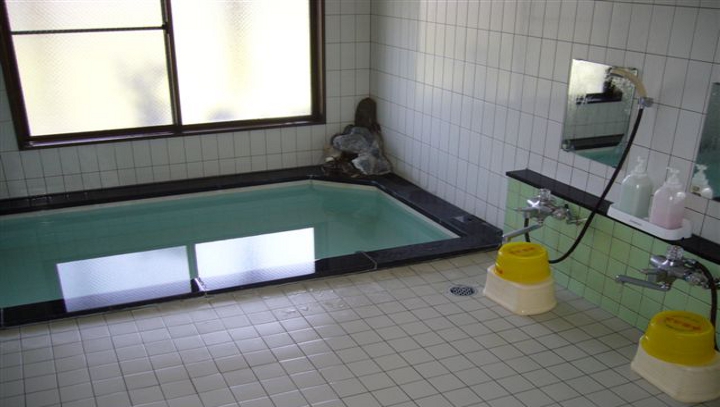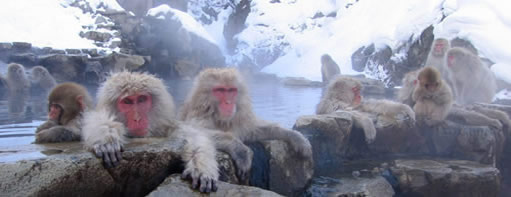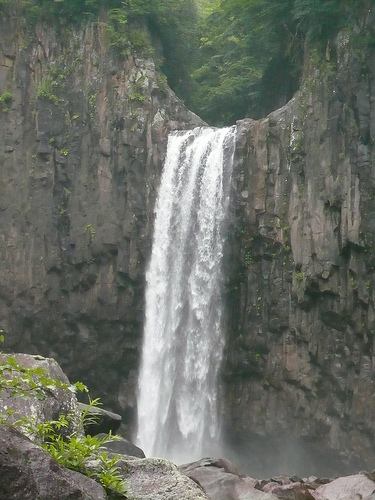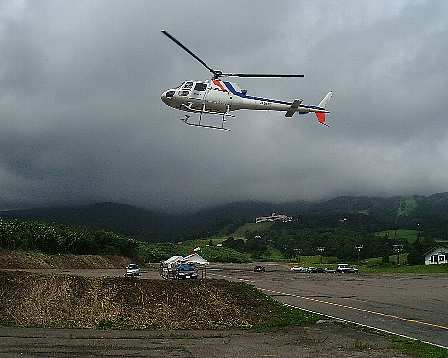
Check out all of the things to see and do in the local area – Fun Parks, Snow Monkeys, Ninja Village, Waterfalls, Historical Sights, plus much much more!
Myoko Sighteeing, Sightseeing in Myoko-Nagano region
See also: Twelve things to do in Myoko Kogen
Japan Monkey Onsen Park – Click here

Nagano Snow Monkey Park
A visit to the area would not be complete without seeing the Jigokudani Monkey Park (地獄谷野猿公苑 Jigokudani Yaen Kōen) in Yamanouchi Town, Nagano Prefecture – near Iiyama and Nakano. See here for full Jigokudani snow monkey information andhotels.
Fun and Amusement Parks
There’s a small fun park in Sekiyama called ‘Myoko Sunshine Land‘ which is open during the warmer months (April to November). The park is mainly geared toward families and younger children and some rides (such as the roller coaster) are only opened during the busy August season. Catch the train to Sekiyama, then take a taxi from there which costs about ¥1,000. Admission is ¥500 for adults or ¥300 for children under 15. Buy a book of ¥100 coupons and use them to purchase rides (most rides cost ¥200-¥300).
Togakushi Ninja Village
The local Togakushi Ninja Village (Togakushi Ninja Yashiki or Chibikko Ninja Mura) is not an actual village full of ninja or a place to study ninjutsu (see below) but rather a fun and popular place to visit with a ninja theme. It’s open 9am-5pm (late April – late November) and closed Thursdays (except mid-July to late August). Admission for adults is 450yen and children (over 4) 200yen. Some group packages are available. There is another attraction nearby named Togakushi Ninja Karakuri Yashiki (Ninja Trick House) which is quite fun, although a bit more geared toward adults or older children. It’s also open 9am-5pm. To get there catch the bus to Chusha-miya-mae and walk about 15 minutes (more directions here).
Togakushi Ninja Museum
There is also a ninja museum in Togakushi Village. Togakushiryu Ninpo Shiryokan is a former ninjutsu building now established as an annex to the Togakushi Minzokukan. It’s exhibits include 500 items related to ninjutsu and two hundred picture panels of ninjutsu practices.
Historical Sites
A number of historical sites litter the nearby countryside.
Myokokogen: Perhaps the most famous is the Sekigawa Guard House. In the olden days all visitors coming from Edo (Tokyo) and the Kanto Plains to Echigo had to pass through this point. Today one can visit the museum and gardens on the old site. It is open 9.00-5.00 and admission is ¥500. Phone 0255-86-3280 for more details.
Tenshin Okakura, a pioneer of Japanese modern arts, and once the president of Tokyo Art School (today’s Tokyo National University of Fine Arts and Music), loved Myoko for its richness of nature so much that he built a mountain villa here in his later years. Within its site, Okakura Tenshin Do, which imitated Yumedono of Horyu-ji Temple was built and there is a gold-gilt statue of Tenshin in it.
The Myoko Kogen Visitor Centre in Ikenotaira, near Imore-Ike (Imore Pond), has a small but interesting collection of local memorabilia, natural exhibits and geographic information.
Joetsu City: The Japanese Ski Memorial Museum, opened in April 1992, was built to commemorate the 80th anniversary of the birth of skiing in Japan near Joetsu. In order to heighten the appeal of Joetsu to the rest of Japan, the building was enlarged and the exhibits increased. The refurbished museum was opened in February 1997 prior to the Nagano Winter Olympics in 1998. Admission is 300 yen (closed on Mondays).
Nagano:
Lake Nojiri Naumann Elephant Museum includes an exhibition of the fossils of Naumann Elephant and Big-horned Deer from Jomon times around 40,000 years ago. These were excavated in the Lake Nojiri area and are displayed together with an exhibition of stone tools and bone tools.
In Shinanomachi lies the home of the revered Japanese poet, Issa.
Togakushi Shrine nestling amongst 900 year old cedars is just 45 minutes drive from Myokokogen. It’s not only a beautiful place to visit but it’s delicious sobanoodles are also famous throughout Japan.
If passing through Nagano City don’t miss the chance to visit Zenkoji Temple. Catch the Dentetsu line train to Gondo or Zenkoji stations and then walk about 10 minutes.
Arai: Hida Village 斐太 is a great place to admire the very old Hida shrine (established in 807), where once, a long time ago medicine for paralysis was made. You’ll also find a 500 year old, 30 meters high and 5.5 meters wide Zelkova tree, which is considered to be a deity, and used to be the Tree of Arai City (now Myoko). If you feel like exploring more history, you can visit the Museum, which displays earthenware vessels of the Hida ruins and Mangoro Old Tomb, ancient folk art, and farm implements. There are about 400 exhibits in all. At the end of your visit you can relax by the pond, do some fishing, or have a picnic! Hida village is a good place to visit from spring to autumn.
Joetsu: Kasuga Mountain Castle was an impregnable mountain castle and once the home of warlord Uesugi Kenshin. Many remnants of the castle including mounds, moats, and wells remain to this day. Located in Nakayashiki, admission is free.
Waterfalls
The Naena taki (Falls) past Suginosawa (see right) were known as one of the best 100 in Japan. Unfortunately the surrounding cliffs were damaged due to floods in 1995 but the area is still quite attractive. There is a nearby restaurant where you can ‘catch’ your own somennoodles and fish.
Yomoshiro Falls よもしろう滝. Spring is also the time for love and here is a great love story that goes with the Yomoshirou falls. The legend goes that a long time ago there lived a man by the name of Yomo Shirou and he decided to go and catch a trout for his lover. Unfortunately, he fell into the water and never returned. Out of deep sadness for their lost love his companion decided to follow him. The saying goes, “If you look well into the falls you can still see the two of them swimming together happily ever after”. This place is great to visit from spring to autumn…escape the humidity for a while, go for a short hike, enjoy the scenery, and refresh yourself.
The Sou Waterfall past Seki is also very pretty. Some of these waterfalls are featured in the video on our hiking page.
Helicopter Rides
Helicopter flights leave down from the Akakura Kanko Hotel on certain dates between May and October. The cost is ¥3,500 for children and ¥4,500 for adults. For information and bookings phone 0255-86-3911. The pilot and manager both speak English.
Noodle-making
Try your skills at making Japanese buckwheat soba-noodles at Nagasawa-chaya 長沢茶屋 in Arai. Having done the noodles you can refresh yourself in the mineral hot spring (i.e. onsen 温泉 ), which is located on the 2nd floor. Afterwards you can eat the soba you’ve made.
You can also check out the Togakushi Soba Museum (open 9am-4.30pm) in Togakushi Village where you can make your own buckwheat soba noodles under the guidance of a master chef or just enjoy watching noodles made by an expert. The ‘A’ Course (instructional) is 3,000 yen, whilst the ‘B’ Course (cook and eat!) is only 700 yen. Both include admission to the museum as well. Courses run daily between 10am-3pm and reservations are recommended.
Bird Watching
More than 100 kinds of wild birds inhabit the Togakushi highlands – one of the most renowned areas in Japan for wild birds. Togakushi Forest Botanical Garden (part of the Joshinetsu National Park) covers over seventy hectares and is visited by many bird watchers and hikers.
Onsen (hot springs) 温泉
Many of the good hotels in the area have onsen plus there are several fine public onsen. These include ‘Landmark’ inIkenotaira, ‘Taki-no-yu’ rotenburo (outside pool) in Akakura or Tsubame Onsen which boasts white yubana (flower shaped crystals) in its mineral rich waters. In the 1950’s Miyami no Sato Village 深山の里 was a home to more than fifty families, but today it is home to only three. The mineral hot-spring will smooth your skin and take the heat and humidness away. This spa is also known as “The spa of beauty!”
Local town onsen are also available and quite inexpensive but usually consist of only ![]() one smallish bath. Look for the following symbol on maps and signs when seeking onsen. Check this mountain onsen page for further details
one smallish bath. Look for the following symbol on maps and signs when seeking onsen. Check this mountain onsen page for further details
Index: Hiking and Mountain Climbing – Walking – Golf – Onsen & Hot Springs –Falconry – Fun Parks – Mountain Biking – Water Sports – Ninja Village –Ninjitsu Training – Bird Watching – Waterfalls – Historical Sites – Wine Tasting– Tennis – Helicopter Rides – Paragliding –Noodle Making – Shopping – Local Markets – Sumo Wrestling – Local Beer & Breweries
Myoko Sightseeing, Sightseeing in Myoko-Nagano




